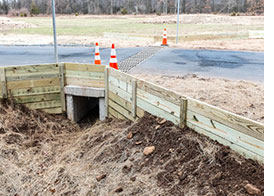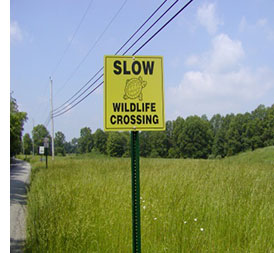|
FOR IMMEDIATE RELEASE |
Contact: Caryn Shinske (609) 984-1795 |
|
NEW UNDERGROUND TUNNEL TO HELP WILDLIFE CROSS ROAD UNVEILED IN BEDMINSTER (15/P53) TRENTON – Crossing a busy road in Bedminster is about to get much easier for turtles and small mammals, now that a new underground wildlife passageway is open in the township, the Department of Environmental Protection’s Division of Fish and Wildlife announced today. “One of our missions is to ensure the sustainability of New Jersey’s many wildlife species,” said David Chanda, director of the Division of Fish and Wildlife. “This innovative tunnel project will help facilitate movement of wildlife successfully across the road, truly a win-win for both wildlife and people.” The DEP approved permits for the project in 2012 as part of a larger plan to enhance recreation opportunities on township land in Bedminster. The DEP, township and project partner New Jersey Audubon Society worked together to develop and complete the $90,000 project, which was paid for by the township. “The wildlife tunnels in place now, along with fencing that will guide animals to the tunnels, offer a long-term solution to minimizing the number of animals being killed along this section of road,” said Brian Zarate, senior zoologist with the Division of Fish and Wildlife’s Endangered and Nongame Species Program. “While this program is designed around the state-threatened wood turtle, a wide variety of animals will be able to use the same structures to safely move back and forth.”
Bedminster Mayor Steve Parker is pleased the crossing is open for wildlife use. “We are pleased to have completed this project in support of the Department of Environmental Protection,” Parker said. “We are happy the project was completed effectively with local resources, at a reduced cost to the taxpayer, and we certainly hope it is successful in protecting wildlife species along River Road.” Several scientific studies have shown that well-designed and well-placed wildlife passageways are extremely effective at reducing the number of animals killed on roadways. Montclair State University faculty and students have begun a study at the River Road site to determine the tunnels’ effectiveness in reducing wildlife-vehicle collisions and maintaining or restoring movement corridors for wildlife. “Reconnecting our fragmented landscapes will allow us to realize the potential of our conserved lands to restore and secure our wildlife heritage for generations to come,” said David Jenkins, chief of Fish and Wildlife’s Endangered and Nongame Species Program. “A changing climate that will require wildlife to move and adapt to shifting habitats adds urgency to putting solutions like this one at River Road ‘on the ground.’” | |
|
### |
|
|
|
|
 For years, numerous turtles, frogs, snakes and small mammals have been killed along a section of Bedminster’s River Road in Somerset County, a main corridor that runs parallel to the nearby Raritan River and links Central New Jersey’s busy Route 202 and Interstate 78. Consequently, the DEP has taken steps to protect the wildlife in this area by installing a first-of-its-kind tunnel system to help these animals cross River Road safely.
For years, numerous turtles, frogs, snakes and small mammals have been killed along a section of Bedminster’s River Road in Somerset County, a main corridor that runs parallel to the nearby Raritan River and links Central New Jersey’s busy Route 202 and Interstate 78. Consequently, the DEP has taken steps to protect the wildlife in this area by installing a first-of-its-kind tunnel system to help these animals cross River Road safely. Animals move around for many reasons, particularly feeding, breeding or migrating. As a result, they need to be able to move safely through the landscape to find food, mates and protection. Without that ability, certain animal populations can become disconnected, isolated, and over time, dwindle, be listed as endangered or threatened, or ultimately disappear.
Animals move around for many reasons, particularly feeding, breeding or migrating. As a result, they need to be able to move safely through the landscape to find food, mates and protection. Without that ability, certain animal populations can become disconnected, isolated, and over time, dwindle, be listed as endangered or threatened, or ultimately disappear.